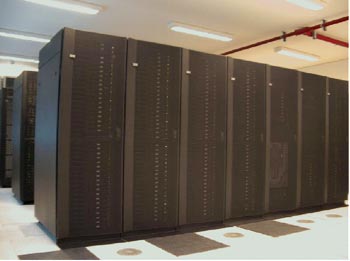| 2006 |

|
YEAR BOOK |
Trinity College Dublin
|
IITAC launches a visualization facility for Ireland
|

Visualization
Increasingly, the most important scientific problems can only be tackled by multidisciplinary teams of researchers. New facilities and collaborative tools are vital to enable scientists to communicate with each other in an effective and transparent way. One method used by IITAC to address these challenges is the development of visualization facilities and software. The recently installed IITAC visualization facility comprises of an impressive 5.6 x 2.3m (20 foot) rear projected flat screen with stereoscopic display properties. The facility was installed by SGi and Fakespace. The image is projected by two Christie Mirage 2000 S+ projectors driven by an eight processor SGi Prism. Scientists use virtual reality technology and special shutter glasses to convert their data into 3D viewable objects which appear to float in space in front of the screen. A high-end ultrasonic tracking system is used to monitor the position of interactive devices allowing the scientist to manipulate and modify their 3D images.
Computational modelling and vis-ualization techniques are used by researchers to gain greater insight into problems in their field of research � IITAC researchers in Chemistry, Biochemistry, Pharmacy and TCHPC have developed new visualization applications in solid state material analysis and in-silico drug-design. Visualization is often used as an aid to help explain complex systems to collaborators and spectators from multiple scientific backgrounds.
Trinity College is at the cutting edge of graphics and visualization research. IITAC researchers in Computer Science have developed new methods for the realistic depiction of scientific phenomena, physically based animation, and complex virtual environments (such as "Virtual Dublin"). The results have been published in the highest impact graphics and visualization journals and conferences, and the School recently hosted the 26th annual conference of Eurographics, the European Association for Computer Graphics, which attracted over 460 international delegates to TCD. See http://www.tchpc.tcd.ie/systems/vis/
A visualization facility for Ireland

Contact: Prof. Graeme Watson, Director,
Trinity Centre for High Performance Computing,
Lloyd Institute, Trinity College, Dublin 2. Ireland.
Web; http://www.tchpc.tcd.ie/